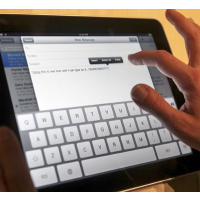L.A. Schools Chief Abruptly Ends $1-Billion iPads-for-All Program
 iPad (photo: Reuters)
iPad (photo: Reuters)
The Los Angeles Unified School District’s (LAUSD) ambitious and controversial $1-billion program to equip each of its 640,000 students with iPads came to a crashing halt Monday, as schools Superintendent John Deasy and his chief lieutenant came under fire for previously undisclosed links to vendors.
The Los Angeles Times reported that Deasy informed the board of his decision not to expand the program beyond its initial $30 million outlay, citing “an ever-changing marketplace and technology advances” and “concerns raised” about the project.
Times reporters wrote last week about an early peek they got at a school district internal draft report critical of the program that cited a lack of transparency during the bidding process. Among its complaints, the report said that project specifications were changed after much of the competition had been eliminated from the process. It also cited appearances of a conflict of interest between Deasy, his staff and vendors.
E-mails that were recently released showed that Deasy and then-deputy Jaime Aquino were holding private discussions two years ago with Apple Corp. and Pearson Education over providing the hardware and software a year before the public process began.
“Understand your points and we need to work together on this quickly,” Deasy wrote at the tail end of an email exchange that Aquino was having with folks at Pearson, where he was an executive before joining LAUSD. Aquino had advised them earlier in the correspondence, “I believe we would have to make sure that your bid is the lowest one.”
Deasy said the exchange concerned a pilot program, and was not a prelude to the formal negotiations and bidding process that took place a year later.
The district was going to spend $500 million in bond money for the computers and another $500 million on Wi-Fi and incidentals. The decision to use bond money earmarked for school construction and repair work to kickstart the program was not universally popular.
In May, LAUSD bounced its most vocal critic, architect Stuart Magruder, off the Bond Oversight Committee but put him back on a month later after his sponsor, the American Institute of Architects Association (AIAA), led a chorus of complaints about the move.
Problems surfaced immediately in the very limited first-stage of the iPad rollout. Virtual keyboards proved impractical, so $38 million in real keyboards was put on the tab. Kids hacked their way past security barriers to use banned social media—and access websites they legitimately needed for homework. The district belatedly struggled to create a policy for handling lost or broken iPads.
The iPad project sent shock waves through a community already distressed by its miserable education system. Last week, a new $1-billion computer system meant to handle enrollment, attendance, grades, counseling, discipline and myriad other tasks was driving teachers, parents and students nuts.
My Integrated Student Information System (MiSiS) was responsible for students assigned to wrong classes or not registered at all, while others stood in long lines for answers or were shuffled off to the auditorium. Schedules and records were lost.
–Ken Broder
To Learn More:
L.A. Unified Halts Contract for iPads (by Howard Blume, Los Angeles Times)
iPad Report Shared Only with LAUSD Officials in Secrecy (by Vanessa Romo, LA School Report)
L.A. School Board Reinstates Critic of $1 Billion iPad Project to Advisory Board (by Ken Broder, AllGov California)
- Top Stories
- Controversies
- Where is the Money Going?
- California and the Nation
- Appointments and Resignations
- Unusual News
- Latest News
- California Forbids U.S. Immigration Agents from Pretending to be Police
- California Lawmakers Urged to Strip “Self-Dealing” Tax Board of Its Duties
- Big Oil’s Grip on California
- Santa Cruz Police See Homeland Security Betrayal in Use of Gang Roundup as Cover for Immigration Raid
- Oil Companies Face Deadline to Stop Polluting California Groundwater





